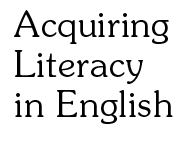Acquiring Literacy in English:
Crosslinguistic, Intralinguistic, and Developmental Factors
Subproject 1: Early Childhood Study of Language and Literacy Development of Spanish-Speaking Children
| Project Period 2000-2005 | |
| Principal Investigator: | Patton O. Tabors, Harvard Graduate School of Education |
| Co-Investigator: | Mariela Páez, Boston College |
| Project Period 2005-present | |
| Principal Investigator: | Nonie K. Lesaux, Harvard Graduate School of Education |
Purpose
Study Subjects
Study Findings
Further Information
PURPOSE
Subproject 1 was a longitudinal study of the English literacy development of native-Spanish-speaking children from pre-kindergarten (pre-K) through the end of second grade. The study investigated the influence of variables such as home literacy, language proficiency in Spanish and English, language of instruction, and quality of instruction on the trajectory of these children’s reading development, and began to address the question of how to differentiate reading difficulties that stem from limited experience with and proficiency in English from those not primarily related to English language learning. The study began in fall 2000 and continued through spring 2005.
The study focused on identifying the factors that influence the course of English literacy development for young Spanish-speaking children. It was designed to answer three interrelated research questions:
- What are the language and early literacy skills in Spanish and English of young Spanish-speaking children as they enter and as they leave pre-K?
- How do these children’s language and early literacy skills in Spanish and English change over time from pre-K through second grade?
- What precursor factors from their home and school contexts predict Spanish-speaking children’s Spanish and English literacy abilities in second grade?
STUDY SUBJECTS
The subjects of the study were native-Spanish-speaking children who were four year olds when the research began. Three hundred and fifty children were recruited from Head Start and public pre-K programs in Massachusetts and Maryland in Year 1; 61 additional children were recruited in the spring of 2002, while the sample was still in pre-K, in order to replace children who had left the study that year. At the end of the study, 305 children were still participating.
STUDY FINDINGS
The main findings from this study are summarized below in reference to the three research questions.
Research Question 1: What are the language and early literacy skills in Spanish and English of young Spanish-speaking children as they enter and as they leave pre-K?
Findings: The children in the sample demonstrated considerable variability in their dual language skills at age four. On average, oral language abilities, particularly vocabulary, were low in both languages when compared to monolingual children of the same age. With respect to early literacy skills, the children were just beginning to grasp the concepts being assessed in both languages.
Research Question 2: How do these children’s language and early literacy skills in Spanish and English change over time from pre-K through second grade?
Findings: The children experienced significant growth in phonological awareness and literacy skills from pre-K to second grade. These skills are amenable to instruction and appear to be highly related across languages, irrespective of the language in which they are learned. The oral language abilities of the sample demonstrated great variability and students’ performance on these standardized tests was below average in both English and Spanish when compared to monolingual norms.
Research Question 3: What precursor factors from their home and school contexts predict Spanish-speaking children’s Spanish and English literacy abilities in second grade?
Findings: Family immigration history was a significant predictor for both Spanish and English literacy ability in second grade. Children whose parents had immigrated relatively recently and valued maintenance of Spanish in the home tended to score higher in Spanish, whereas children whose parents had been in the U.S. longer and emphasized the importance of English tended to score higher in English. Parents whose children scored higher in both Spanish and English had higher educational levels and regarded bilingualism as an asset.
Classroom quality was a school-context factor that had a significant impact on changes in the children’s ability levels in both Spanish and English. Use of Spanish in the classroom had a significant impact on changes in the children’s ability levels in Spanish.
A finding of note was that the children consistently performed better on literacy measures than on oral language tasks in both English and Spanish. Oral language revealed itself as an area of significant concern; on average, the children in the sample scored more than one standard deviation below the mean for monolingual children in both languages. The children made better than expected gains in oral skills from pre-K to second grade, but these gains were small in absolute terms and did not appreciably alter the overall standing of the sample.FURTHER INFORMATION
Read subproject summary [PDF, 42.7KB] ![]()
View list of publications resulting from the study
Read descriptions of assessments developed for the study
- Parent Interview Response Sheet
- Phonological Awareness Task (English and Spanish)
- Narrative Production Task (English and Spanish)
- Book Task (English and Spanish)

